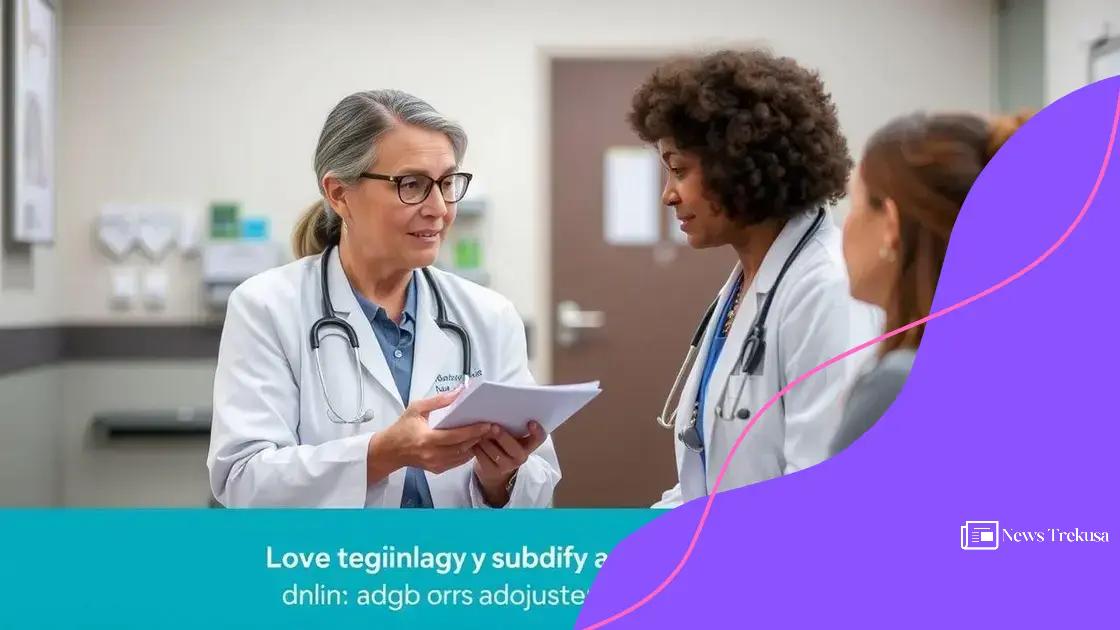Healthcare subsidy adjustments: what you need to know

Healthcare subsidy adjustments directly affect insurance affordability and accessibility, allowing more individuals to gain necessary coverage and manage healthcare costs effectively.
Healthcare subsidy adjustments play a crucial role in determining how accessible medical care is for many people. If you’ve ever wondered how these changes affect your wallet and health access, you’re not alone.
Understanding healthcare subsidies
Understanding healthcare subsidies can seem complicated, but it’s essential to grasp how they work and the impact they have on your health costs. These subsidies are designed to help individuals pay for their medical expenses. By learning about them, you can make more informed decisions about your healthcare options.
What Are Healthcare Subsidies?
Healthcare subsidies are financial assistance programs that help lower the cost of health insurance premiums and out-of-pocket expenses. They are a vital part of the American healthcare system, enabling many people to afford necessary care.
Types of Healthcare Subsidies
- Premium tax credits: These subsidies reduce what you pay monthly for your health insurance plan.
- Cost-sharing reductions: These subsidies help decrease your out-of-pocket costs, such as deductibles and co-payments.
- Medicaid expansion: Some states have expanded Medicaid to cover more low-income individuals, offering additional support.
Subsidies vary by income level and depend on several factors, including the size of your household and the total household income. If your income is below a certain threshold, you may qualify for more assistance.
It’s important to understand that not everyone is eligible for these subsidies. They are usually available to individuals who purchase insurance through the Health Insurance Marketplace. If you’re unsure of your eligibility, it’s worthwhile to check during the enrollment period.
In addition to affordability, healthcare subsidies also contribute to broader public health goals. They help ensure that more individuals have access to preventive care and necessary treatments, which ultimately leads to healthier communities.
Why Understanding Subsidies Matters
Knowing about healthcare subsidies can help you save money. For some people, these subsidies make the difference between being uninsured and having adequate health coverage. Additionally, understanding your options can empower you to select the best plan that meets your needs.
Being informed about these changes ensures you are prepared for enrollment periods and can take advantage of the benefits available to you. The landscape of healthcare is always evolving; staying updated on subsidies can positively impact your health and finances.
Recent adjustments in healthcare subsidies
Recent adjustments in healthcare subsidies have brought significant changes to how individuals manage their healthcare costs. It’s essential to stay informed about these updates to ensure you can maximize your benefits.
Overview of Recent Adjustments
The federal government occasionally revises subsidy programs, and these adjustments can alter eligibility and benefit levels. For instance, changes were implemented to increase income thresholds, allowing more people to qualify for assistance. This means that if your income recently changed, you might be eligible for more subsidies.
Impact on Consumers
- Lower Costs: Many individuals have reported reduced premium costs thanks to recent adjustments.
- More Coverage Options: With more individuals qualifying, insurance companies are offering diverse plans.
- Increased Access to Care: These subsidies help more people afford insurance, improving overall healthcare access.
Understanding how these changes impact you is crucial. For those who previously didn’t qualify, these adjustments might be the opportunity to gain necessary coverage. It’s worth checking the healthcare marketplace this year to see if you can benefit.
As healthcare evolves, keeping track of these updates ensures you are not missing out. Staying informed can lead to significant savings and better health outcomes. Inspecting your current plan and being proactive about enrollment can make a huge difference.
Key Considerations Moving Forward
As you consider your options, remember to check if your location also affects your eligibility. Some states have their own subsidy programs, which can vary widely from federal offerings. Additionally, always review your pay stubs or tax returns, as these documents can influence your subsidy qualifications.
Impacts of subsidy changes on patients

The impacts of subsidy changes on patients are critical to understand, as they directly influence healthcare accessibility and affordability. When subsidies are adjusted, patients may experience significant shifts in how they manage their healthcare expenses.
Financial Implications
For many individuals, changes in subsidies can lead to lower or higher monthly premium costs. This fluctuation can affect budgeting, making healthcare more or less affordable. Understanding these financial implications is vital for patients making decisions about their health coverage.
Access to Care
- Increased Access: If subsidies increase, more patients can afford insurance, leading to greater healthcare access.
- Limited Choices: Conversely, if subsidies decrease, some patients may find themselves with fewer options for coverage.
- Delaying Care: Higher costs may force some patients to delay necessary treatments or check-ups.
These impacts illustrate the importance of understanding one’s eligibility for subsidies. When patients are aware of the changes, they can better navigate their healthcare options. Having access to timely information can empower them to make informed decisions during open enrollment periods.
Moreover, subsidy adjustments can also impact the mental and physical health of patients. For example, when people have access to affordable care, they are more likely to seek preventive services. This helps manage chronic conditions and leads to better overall health.
Long-term Effects
Over time, the effects of subsidy changes can alter health outcomes within communities. If more individuals access necessary care, this can lead to enhanced public health. On the other hand, if subsidy adjustments push individuals away from getting insurance, healthcare disparities may widen.
Being proactive about understanding these changes helps patients advocate for themselves. It encourages them to stay engaged in their healthcare decisions, ensuring they receive the best possible care.
Navigating new healthcare costs
Navigating new healthcare costs can be challenging, especially after recent subsidy adjustments. Understanding how these changes impact your expenses is vital for managing your health budget.
Understanding Your Costs
New healthcare costs can include premiums, deductibles, and out-of-pocket expenses. It’s important to familiarize yourself with these terms to effectively navigate your options. Knowing what to expect can prevent surprises when medical bills arrive.
Factors Affecting Your Costs
- Income Level: Your income determines your eligibility for subsidies, which can significantly affect your overall costs.
- Family Size: The number of people in your household also impacts the availability and amount of subsidies.
- Type of Coverage: Different plans may offer varied coverage levels, influencing your costs for services.
When assessing these costs, think about potential future healthcare needs. Anticipating future expenses can help you choose the best plan suited for your situation.
Additionally, it is wise to compare plans during open enrollment periods. Make sure to investigate any changes to your plan’s network and covered services, as these factors can impact your total expenses.
Utilizing Resources for Assistance
There are many resources available that can help you understand and manage your healthcare costs. State marketplaces and healthcare navigators can provide personalized assistance. They can guide you through the process of applying for subsidies and selecting a plan that fits your needs.
Being proactive in understanding your healthcare costs empowers you to make informed decisions. It allows you to plan your budget effectively while ensuring that you have access to necessary medical care.
Future of healthcare subsidies
The future of healthcare subsidies looks promising as ongoing reforms aim to enhance access and affordability. Understanding these changes can help individuals and families plan better for their healthcare needs.
Trends in Healthcare Subsidies
One major trend is the potential for increased funding. Policymakers are discussing ways to allocate more resources for subsidies, making them available to a broader range of income levels. This could mean more people will qualify for assistance than ever before.
Technological Advancements
- Online Platforms: Online platforms are becoming more user-friendly, allowing patients to easily access information about available subsidies.
- Data Analytics: Better data analytics can help identify individuals who might not realize they are eligible for subsidies.
- Telehealth Services: Expanding telehealth can provide more options for patients, complementing their insurance plans.
In the coming years, technology will continue to play a significant role in shaping how subsidies are managed and accessed. With more streamlined processes, patients may find it easier to navigate their options.
Potential Policy Changes
Future policies may also focus on eliminating gaps in coverage. By addressing the needs of uninsured populations, the goal is to create a more inclusive healthcare system. If successful, this could lead to better health outcomes across communities.
Understanding these future dynamics is essential for anyone involved in the healthcare system. Remaining informed about changes in subsidies can assist individuals in making informed choices about their healthcare options. As the landscape evolves, being proactive will position patients to take advantage of new programs and resources.
In conclusion, understanding the future of healthcare subsidies is essential for making informed choices. As healthcare continues to evolve, staying aware of subsidy changes can help ensure access to necessary medical care. With potential policy improvements and technological advancements, more people may benefit from available resources. Being proactive in learning about your options can lead to better health outcomes and improved financial stability. Remember, every individual has the right to affordable healthcare, and staying informed is the first step to making the best decisions for your wellbeing.
FAQ – Frequently Asked Questions About Healthcare Subsidies
What are healthcare subsidies?
Healthcare subsidies are financial assistance programs that help individuals afford health insurance premiums and out-of-pocket healthcare costs.
How can I determine if I’m eligible for subsidies?
Eligibility for healthcare subsidies typically depends on your income level, household size, and whether you purchase insurance through the Health Insurance Marketplace.
What impacts do recent subsidy changes have on patients?
Recent subsidy changes can lower premium costs, increase coverage options, and make healthcare more accessible for many individuals.
How can I stay informed about future changes in healthcare subsidies?
Staying informed can involve regularly checking official health resources, engaging with community health organizations, and consulting with healthcare navigators during open enrollment periods.
SEE MORE CONTENT
